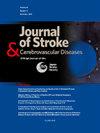The neutrophil-to-lymphocyte ratio is associated with functional outcome among single small subcortical infarction: Mediating effects of white matter hyperintensities
IF 2
4区 医学
Q3 NEUROSCIENCES
Journal of Stroke & Cerebrovascular Diseases
Pub Date : 2025-05-08
DOI:10.1016/j.jstrokecerebrovasdis.2025.108341
引用次数: 0
Abstract
Background
Increasing evidence indicated that neutrophil-to-lymphocyte ratio (NLR) was correlated with unfavorable functional outcome in ischemic stroke. However, limited studies have explored the relationship between NLR and single small subcortical infarction (SSSI). This study aims to investigate the link between NLR and functional outcome in patients with SSSI and assess whether white matter hyperintensities (WMH) mediates the relationship between NLR and unfavorable functional prognosis.
Methods
This research analyzed data from patients with SSSI in a Chinese cohort study. The primary outcome was unfavorable functional outcome (modified Rankin Scale score of 2-6) at 90 days after ischemic stroke onset, and the secondary outcome was unfavorable functional outcome at discharge. The relationship between NLR and functional outcome was analyzed using restricted cubic spline (RCS) and multivariable logistic regression. A mediation analysis was conducted to examine the link between NLR and unfavorable functional outcome mediated by WMH.
Results
Among the 513 patients with SSSI included in the study, unfavorable functional outcome was seen in 145 (28.3 %) patients at the 90-day follow-up and 156 patients (30.4 %) at discharge. After controlling for confounding variables, elevated NLR levels were found to be linked with unfavorable functional outcome both at 90 days and at discharge. Mediation analyses indicated that overall WMH significantly mediated the relationship between NLR and unfavorable functional outcome at 90 days and discharge, with mediation proportions of 29.6 % and 24.2 %, respectively. Periventricular WMH accounted for 36.4 % and 32.1 % of the mediation effects, respectively.
Conclusion
Elevated NLR independently increased the risk of unfavorable functional outcome in individuals with SSSI. In patients with SSSI, WMH partially mediated the relationship between NLR and unfavorable functional outcome.
中性粒细胞与淋巴细胞的比例与单个皮质下小梗死的功能结局有关:白质高信号的介导作用。
背景:越来越多的证据表明,中性粒细胞与淋巴细胞比率(NLR)与缺血性卒中的不良功能预后相关。然而,有限的研究探讨了NLR与单一小皮质下梗死(SSSI)之间的关系。本研究旨在探讨SSSI患者NLR与功能预后之间的关系,并评估白质高强度(WMH)是否介导NLR与不良功能预后之间的关系。方法:本研究分析了中国队列研究中SSSI患者的数据。主要结局是缺血性卒中发病后90天的不良功能结局(修正Rankin量表评分为2-6),次要结局是出院时的不良功能结局。采用限制三次样条(RCS)和多变量logistic回归分析NLR与功能预后的关系。我们进行了一项中介分析,以检验NLR与WMH介导的不良功能结局之间的联系。结果:在纳入研究的513例SSSI患者中,145例(28.3%)患者在90天随访时出现不良功能结局,156例(30.4%)患者在出院时出现不良功能结局。在控制混杂变量后,发现NLR水平升高与90天和出院时的不良功能结局有关。中介分析表明,总WMH显著中介NLR与90天及出院时不良功能结局的关系,中介比例分别为29.6%和24.2%。心室周围WMH分别占中介效应的36.4%和32.1%。结论:NLR升高单独增加了SSSI患者不良功能结局的风险。在SSSI患者中,WMH部分介导了NLR与不良功能预后之间的关系。
本文章由计算机程序翻译,如有差异,请以英文原文为准。
求助全文
约1分钟内获得全文
求助全文
来源期刊

Journal of Stroke & Cerebrovascular Diseases
Medicine-Surgery
CiteScore
5.00
自引率
4.00%
发文量
583
审稿时长
62 days
期刊介绍:
The Journal of Stroke & Cerebrovascular Diseases publishes original papers on basic and clinical science related to the fields of stroke and cerebrovascular diseases. The Journal also features review articles, controversies, methods and technical notes, selected case reports and other original articles of special nature. Its editorial mission is to focus on prevention and repair of cerebrovascular disease. Clinical papers emphasize medical and surgical aspects of stroke, clinical trials and design, epidemiology, stroke care delivery systems and outcomes, imaging sciences and rehabilitation of stroke. The Journal will be of special interest to specialists involved in caring for patients with cerebrovascular disease, including neurologists, neurosurgeons and cardiologists.
 求助内容:
求助内容: 应助结果提醒方式:
应助结果提醒方式:


